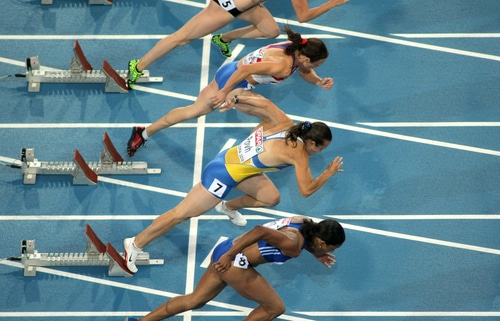
Strength versus Power: What’s the Difference?
Athletic strength refers to an athlete’s ability to move or lift a heavy weight. Who wouldn’t be impressed by the strength of a weightlifter like Ryan Kennelly who holds the world record for bench press? He successfully pressed 1,074 pounds, a feat that has yet to be duplicated. Strength is measured by an athlete’s one-rep max, the maximum amount of weight he or she can lift for a single repetition.
So how does power differ from strength? Power adds another element to the equation – time. Power takes into account not only at how much force an athlete can generate but how quickly they can do it. When an athlete power lifts at the gym, he or she typically moves the weight slowly through space. Time isn’t a consideration, only how much total work or force they can generate.
Power is more dynamic. It looks at how much time it takes to generate a particular force or do a certain amount of work. Power is the ability to create force very quickly. Think of power as the force an athlete generates during a vertical jump. With power, how fast you do it counts.
Strength versus Power: Which is More Important?
When it comes to being successful in sports, performance is most closely linked with power. Athletes playing sports like basketball, volleyball or soccer must be able to create force quickly. When a volleyball player jumps to spike the ball, they need more than just strength – they need power. Without the ability to generate force rapidly, they won’t be very successful in their sport.
Most sports emphasize power over strength with the exception of a sport like powerlifting. Even sports like wrestling that would appear to be predominantly strength-based at first glance have an element of power. That’s why athletes won’t necessarily benefit from spending hours in the gym lifting heavy weights. They need power training to help them improve their ability to generate force quickly.
Power Training
If you want to develop power, what’s the best way to do it? Lifting heavy at the gym is a good way to develop strong core and leg muscles that are important for these sports, but it won’t necessarily make a basketball or soccer player better. That’s where power training comes in. One of the best ways to build power is by doing plyometrics. A good workout to try of mine for developing power is my HiiT DVD.
Plyometrics are movements that stretch a muscle and shorten it quickly. Examples of plyometric exercises include plyo lunges, lateral jumps, and squat jumps. These movements all develop explosive power needed for success in a variety of sports. More advanced plyometric training might include box jumps where you squat down and jump onto a platform.
Kettlebell training is another type of exercise that builds power since you’re moving weight quickly through space in a dynamic fashion. You do this by swinging it out in front of you (kettlebell swings) or by explosively raising it above your head (kettlebell snatches). The fast, fluid movements build power, strength, and endurance, all of which improve sports performance.
The Bottom Line?
Strength and power are important, but power is most closely linked to sports performance. If you want to be a well-rounded athlete, spend more time doing exercises like plyometrics and kettlebell training that build explosive power, but don’t neglect strength training. It’s important too.
References:
ACE Fitness. “Plyometrics: Controlled Impact/Maximum Power”
National Strength and Conditioning Association. Volume 27, Number 2.
Related Articles By Cathe:
5 Triple-Duty Exercises that Combine Power, Strength, and Cardio
Complex Training for Building Muscle Strength and Power
Lifting Tempo: What Role Does Rep Speed Play in Strength and Power Gains?
Ramp Up Strength and Power with Plyometric Drills
How Men and Women Differ in Terms of Strength and Power
Related Cathe Friedrich Workout DVDs:
STS Strength 90 Day Workout Program
All of Cathe’s Strength & Toning Workout DVDs
Total Body Workouts
Lower Body Workouts
Upper Body Workouts

